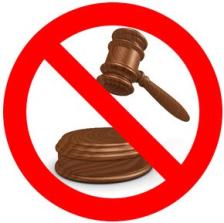Canadian judges do not use gavels
A gavel is a small hammer-like mallet. You may have seen judges pounding gavels in the media. But in Canada, our judges do not use gavels.

Canadian judges have never used gavels. They control court proceedings with their voices and demeanour. In Britain (the source of most of our legal traditions) the judges also do not use them.
Where are they used? In American courts. Even there, popular culture exaggerates the frequency of their use. In online discussion boards, American lawyers report that although there may be gavels in courtrooms around the US, many judges rarely use them.
Understanding our court process
In a 2009 column in the British newspaper The Guardian, Marcel Berlins pointed out the harm done by depictions of trials that give viewers inaccurate impressions of their own country’s legal system. His analysis applies to our country as well.
Canadians rarely get to see their own courts in action as most people cannot get to a courthouse to watch trials, and televising court proceedings is limited for reasons related to balancing public access with witness protection and trial fairness. So, most people’s knowledge of what happens in our courts is based on media reports, television and movies. The problem is that Canadians see far more American legal dramas than Canadian ones, so their perceptions of court procedure are based on the American model and it is different from ours in some significant ways.
Canadian courts are generally conducted in a more respectful, dignified and formal way than what we see on television. Taken by itself, whether Canadians mistakenly believe their judges pound a gavel while shouting, “Order! Order in the Court!” may not be a big issue, but the serenity, patience and respect for others that we expect our judges to display is an important indication of the calm, impartial decision-making we demand from judges in the Canadian justice system.
Depictions of court proceedings without gavels serve an educational purpose. Misleading ones weaken public understanding of our courts and legal system.
Knock it on the head, BBC. Judges don't use gavels (2009 The Guardian article)
